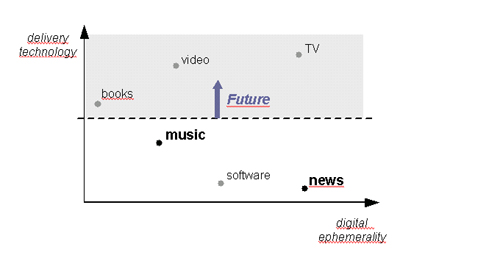| Vision |
| Aim |
| End User Objectives |
Over the past few years it has become clear that the Internet will play an ever greater role in the distribution of digital contents. Specialised portable hardware, designed to store and give digital access to traditional contents such as books, music, or video, will soon make digital contents in all its forms acceptable to broad sectors of the population. Businesses which have adopted to the completely new forms of marketing and distribution will ultimately find themselves with a tremendous competitive advantage over their lagging competitors. What this means is that businesses have to start now understanding the dynamics of this new market and gaining a clear idea of how to exploit the impending paradigm shift in contents marketing and distribution. SimWeb provides businesses with the means to achieve just this vision.
SimWeb will provide European businesses in the digital contents sector with insights and tools which will enable them to take informed business strategy decisions and become more competitive by adapting their traditional business models to the new, demanding reality. To achieve this objective, SimWeb will design and implement sector models based on innovative, reusable, and highly scalable multi-agent simulation technology. These computer-based models, calibrated to market data extracted from extensive sector surveys, will then allow market participants in the digital contents sector to run through an almost unlimited variety of social and economic scenarios, and observe the impact they have on their businesses in particular, and on the competitive digital contents landscape in general. The insights gained during these simulation runs will provide them with an invaluable understanding of the hitherto unexplored dynamics of the market and permit them to adjust their own business models to the new competitive demands. Games will be implemented, which allow non-technical and business-focused users to learn from the results of the simulations and also provide an innovative dissemination process
To ensure a successful project outcome, SimWeb will focus on two particular types of contents: digital music and on-line news. We have chosen this combination for two reasons: (1) the necessary delivery technology for both digital music and news contents is available and widely used, and (2) digital music and news have very different longevities and therefore imply different strategic needs for the businesses concerned. The second point is important for the project in as far as it allows to cover a broader range of scenarios than would be possible with a single narrow topic. In particular, it increases the chances that the results of the SimWeb project will be sufficiently generic to extend them - beyond the life of the project - to other digital sectors such as TV or books.
Two of the three end users operate within in the retail music and news business sectors respectively, and plan to attain a competitive advantage by understanding the implications of a changing market environment and the impact novel digital marketing and distribution paradigms will have on the performance of their businesses. To that end, they will use the sector models developed in the SimWeb project to devise and analyse innovative business strategies that can optimally support the transition to become important players in the digital contents market
The third end user is an eCommerce technology solution developer and strategic consultant, who is poised to gain invaluable insight into the intricacies of the digital contents markets, which in turn will allow them to greatly improve their advisory activities. Their interest however goes further in that they are taking an interest in digital contents sectors beyond the ones investigated during the lifetime of this project. With this particular aim in mind, they will collect the experiences gained during the implementation of SimWeb and synthesise the result in a set of Best Practice Guidelines for building and using socio-economic multi-agent models.
